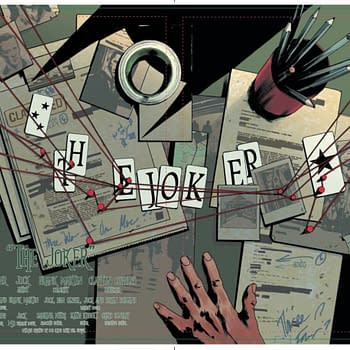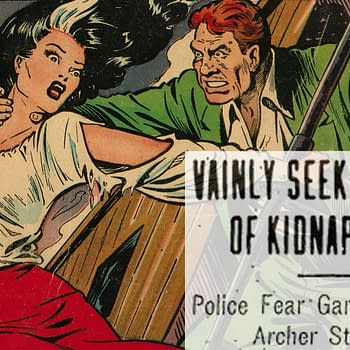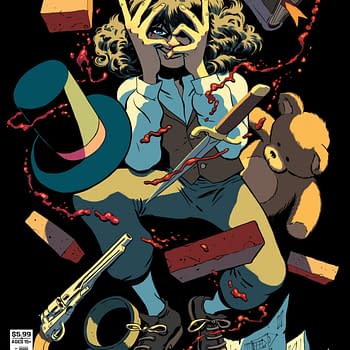Posted in: Comics, Recent Updates | Tagged: Comics, documentaries, entertainment, karen berger, Marisa Stotter, Ramona Fredon, Respect Films, Sequart Research & Literacy Organization, She Makes Comics, women in comics
Talking Women In Comics With She Makes Comics Director Marisa Stotter
By Nikolai Fomich

Nikolai Fomich: What are the secret origins of this project? Why did you decide to create this film?
Marisa Stotter: I started working with my co-producers, Patrick Meaney and Jordan Rennert, in 2013 while they were wrapping up one of their own comics docs, The Image Revolution. Around that time, they were looking for an idea for a new project. I pitched them a film about women in comics, drawing from my interest in recent online discussions about women and their place in the comics world. It took off from there and became She Makes Comics!
NF: The history of women making comics is obviously an enormous topic. Did the scope of the subject matter concern you at all? How did you strike that balance between breadth and depth?
MS: It was definitely a challenge to try and encapsulate such a rich history in a single film, so we made the decision to go for depth with some stories that we felt were representative of particular eras in comics history. The trouble with a documentary that tries to span a long period of time is avoiding the "classroom movie syndrome," where you're throwing a lot of facts at the viewer and little of it has any emotional resonance. So we tried to find the middle ground between demonstrating the breadth of women's involvement in comics and highlighting particular women's stories that we felt were representative of the major milestones of comics history.
NF: She Makes Comics brings together several generations of women who have contributed to the medium – from Ramona Fradon to Trina Robbins to Karen Berger to Kelly Sue DeConnick. Talk a bit about what it was like to interview these creators and speak with them about their experiences in the industry.
MS: It was thrilling for me, as a comics fan and a personal fan of many of these women, to interview them. They were all remarkably candid about their experiences and did not shy away from any detail in telling their stories. Karen Berger was an especially fun interview, because here was this woman who was responsible for many of my favorite comics and graphic novels — and she was the nicest, most down-to-earth person to talk to! The interview process was definitely the high point of the production, both as a filmmaker and as a comics fan.
NF: While conducting your research, what surprised you the most to learn?

NF: As your film points out, women have always worked in comics – from Nell Brinkley in the 1900's to Jackie Ormes in the 1930's. But though serious discussion about female comic creators working in a male-dominated industry goes back at least as far as the 1970's, only recently has this discussion entered into the mainstream. Why do you think this conversation has come to the fore in in recent years?
MS: I really believe that the Internet is a major reason why these discussions are finally happening. The Internet leveled the playing field in a lot of ways by giving a voice to women (and other marginalized groups) and allowing them to tell their stories, to communicate with each other, to challenge popular assumptions about comics. It has allowed women to write their own history and to rewrite the history that exists, and that ability is enormously powerful.
NF: There's been debate over whether the predominance of the superhero genre within American comics is part of the reason there are more male readers than female. Do you buy into that? Do you think there's something inherent in the concept of the superhero that's geared more towards boys than girls?
MS: If you look at the history of comics, there's definitely a point at which women started losing interest, and it correlates with the Comics Code and comics publishers' re-dedication to the superhero genre. I think that has less to do with the inherent appeal of superheroes than it does with the specific content of the books themselves. For many women, there isn't much appeal in reading superhero books in which men are always the hero and women are treated as objects — and that's what superhero books were mostly like back in the 50s and 60s. Today, the genre features female superheroes and characters of all genders who are complex and interesting and have rich interior lives, and the female readership of these books has exploded in size and scope.
I think that gender roles also have a part in this. Popular culture long ago deemed comic books to be a male space, so women were never encouraged to give comics a try. That's definitely changing now, so you're seeing more women going into comic shops who never would have done so a couple of decades ago.
NF: Finally, how do you think we have progressed as an industry in regards to gender equality, and in what ways do you think we need to improve?
MS: There has definitely been a lot of progress over the past ten, fifteen years. There are more women involved in comics and reading comics than ever before. And while women are enjoying great success in indie and webcomics, I think there's still a ways to go in the representation of women in superhero comics. There are a few high-profile women working at the Big Two, for example, but it is not enough to have a handful of women in a creative roster that is otherwise dominated by men. But I think that the publishers are recognizing this and are actively seeking to increase the representation of women behind the scenes.
Many thanks to Marisa for taking the time to speak with Bleeding Cool about She Makes Comics. You can follow her on Twitter @marisastotter.
Nikolai Fomich is a teacher and a writer in Philadelphia. Follow him on Twitter @brokenquiver.
















